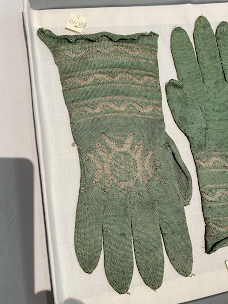St. Eligius Recap 2023

This past Saturday I participated in my second A&S competition at St. Eligius in Dragonship Haven. My project was actually a science experiment instead of something created in an attempt to push my limits. When I created the funeral pillow panel last year, the extant piece was made out of 100% silk and was 26 stitches to the inch. Using a 50/50 wool/silk blend of commercial yarn, I was able to achieve 20 stitches to the inch on size 0000 needles. I'm comfortable spinning fairly fine yarn, so my experiment was to see if I could spin fiber fine enough to knit a swatch which would meet the 26 stitches per inch parameter. Using two dropspindles that each weighed 19 grams, one wooden and one tahkli, I spun two samples each of 50/50 merino/silk and 100% mulberry silk. Each sample was then plied (double strand) on a different dropspindle and knit into a swatch 30 stitches wide using size 0000 needles. I chose the two different types of spindles because the Tahkli would have come fr



